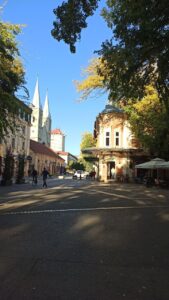The evolution of residential architecture in Subotica: from historic styles to modern minimalism.
Subotica, a picturesque city located in northern Serbia, is renowned for its rich architectural heritage that reflects a diverse cultural history. Over the centuries, residential architecture in Subotica has undergone significant transformations, mirroring broader trends in design, technology, and societal needs. From the ornate details of historic styles to the sleek lines of modern minimalism, the evolution of residential architecture in this city offers a fascinating glimpse into the changing tastes and values of its inhabitants. This article explores the journey of Subotica’s residential architecture, highlighting key styles and movements that have shaped its urban landscape.
Historic Styles: A Reflection of Cultural Diversity
The architectural landscape of Subotica is deeply influenced by its multicultural heritage, which is evident in the variety of historic styles that emerged during the late 19th and early 20th centuries. The city became a melting pot of different cultures, including Hungarian, Serbian, and Jewish influences, each contributing unique elements to the architectural fabric. Notable styles from this period include Art Nouveau, which is characterized by its organic forms and intricate decorative details, as seen in the iconic Raichle Palace. The use of vibrant colors and elaborate tile work in these buildings reflects the artistic aspirations of the time.
In addition to Art Nouveau, the eclectic style also gained prominence in Subotica, showcasing a blend of various architectural influences. This style often incorporated elements from different periods and cultures, resulting in visually striking and unique residential structures. The façades of these buildings were adorned with ornamental features, such as balconies, cornices, and decorative motifs, which served to express the individuality of the homeowners. The historic architecture of Subotica not only highlights the aesthetic preferences of its residents but also serves as a testament to the city’s rich cultural tapestry.
As the 20th century progressed, the impact of modernism began to reshape the architectural landscape of Subotica. While historic styles continued to be appreciated and preserved, the demand for more functional and efficient living spaces led to the emergence of new design philosophies. This transition marked a significant shift in the way residential architecture was conceived, as architects sought to balance aesthetic appeal with practicality and sustainability.
The Mid-20th Century: The Rise of Functionalism
The mid-20th century witnessed the rise of functionalism in residential architecture, a movement that prioritized simplicity and utility over ornate decoration. This shift was largely influenced by the post-World War II era, which called for rapid reconstruction and modernization in many European cities, including Subotica. Architects began to embrace clean lines, open floor plans, and the use of industrial materials, reflecting a growing emphasis on efficiency and affordability in housing design. The result was a new wave of residential buildings that catered to the needs of a changing society.
During this period, the architectural landscape of Subotica saw the introduction of modernist housing complexes, which aimed to provide affordable living options for the growing population. These developments often featured standardized designs and modular construction techniques, allowing for quicker and more cost-effective building processes. While some critics argued that this approach led to a loss of individuality in residential architecture, proponents maintained that it represented a necessary evolution in response to contemporary needs.
Despite the functionalist trend, many residents of Subotica remained attached to the historic styles that characterized their city. This tension between modernism and tradition sparked debates about the preservation of architectural heritage versus the need for innovation. As a result, some architects began to explore ways to integrate modern design principles with the rich historical context of Subotica, leading to a unique blend of styles that would define the city’s architectural identity in the latter half of the 20th century.
Modern Minimalism: A New Era of Design
In recent years, modern minimalism has emerged as a dominant trend in residential architecture in Subotica. This design philosophy emphasizes simplicity, functionality, and a connection to nature, often characterized by clean lines, open spaces, and a limited color palette. The minimalist approach reflects a growing awareness of environmental sustainability and the desire for a more harmonious relationship between architecture and its surroundings. As a result, many new residential projects in Subotica prioritize energy efficiency and the use of sustainable materials.
The shift towards modern minimalism has also been influenced by global architectural trends, as architects and designers increasingly draw inspiration from contemporary practices around the world. In Subotica, this has led to the creation of innovative residential designs that challenge traditional notions of home. These new structures often feature large windows that invite natural light and blur the boundaries between indoor and outdoor spaces, fostering a sense of openness and tranquility.
While modern minimalism represents a departure from the ornate details of historic styles, it does not negate the importance of Subotica’s architectural heritage. Many contemporary architects are finding ways to honor the city’s past while embracing modern design principles. This synthesis of old and new is evident in various residential projects that incorporate elements of traditional architecture, such as pitched roofs and local materials, into minimalist designs. As Subotica continues to evolve, its architectural landscape remains a dynamic interplay between history and innovation.
The evolution of residential architecture in Subotica is a testament to the city’s rich cultural heritage and its ability to adapt to changing societal needs. From the ornate details of historic styles to the clean lines of modern minimalism, each architectural phase reflects the values and aspirations of its time. As Subotica moves forward, the challenge will be to balance the preservation of its architectural legacy with the demands of contemporary living. This ongoing dialogue between tradition and innovation will undoubtedly shape the future of residential architecture in this vibrant city, ensuring that it remains a unique and inspiring place to call home.


